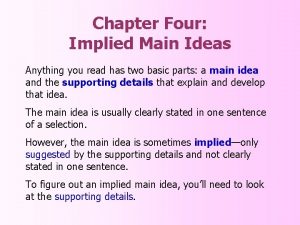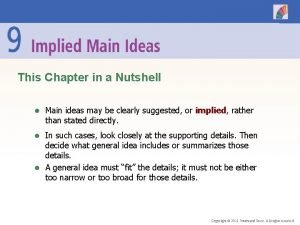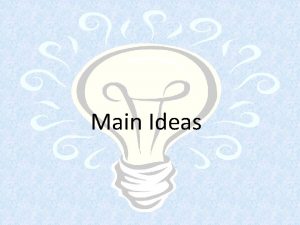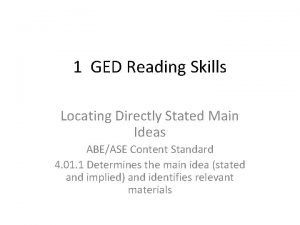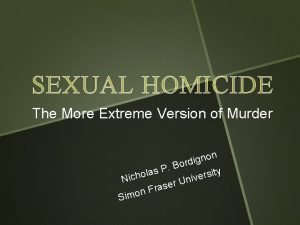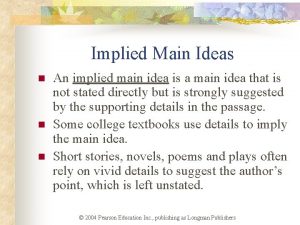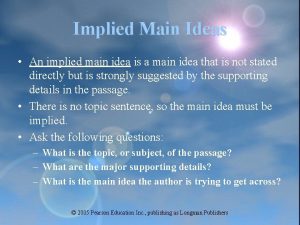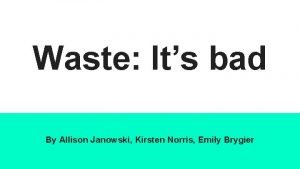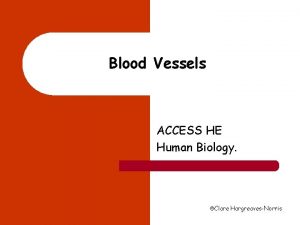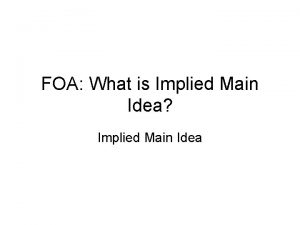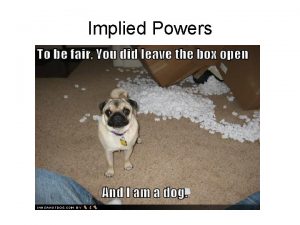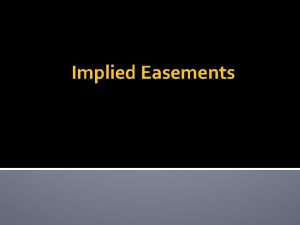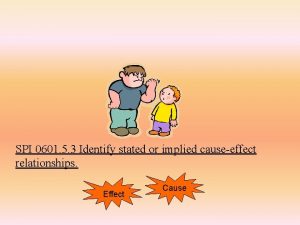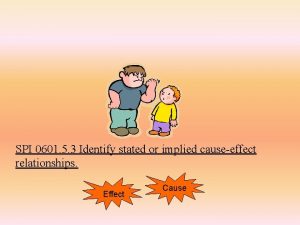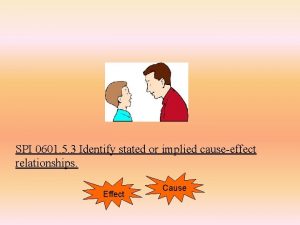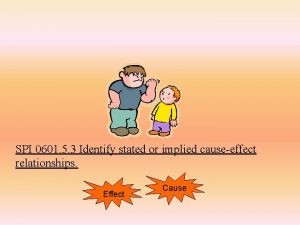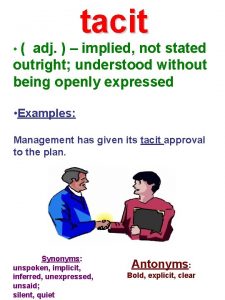Main Ideas Stated and Implied T C NORRIS














- Slides: 14

Main Ideas: Stated and Implied T. C. NORRIS FALL 2016

Definitions

Main Idea • The point the writer wants to make about the subject. Stated • The point the writer wants to make about the subject is clearly identifiable in a sentence. Implied • The point the writer wants to make about the subject is not clearly identifiable in a sentence. The reader must dig for it.

Stated Main Ideas • Stated main ideas will be in the topic sentence. o The focus of the paragraph. o A general statement that covers all of the details in the paragraph. • Topic sentences may be at the beginning, middle, or end of the paragraph, but are usually at the beginning.

Find the Stated Main Idea Your memory operates through three stages to take in, sort, and store information for later use. Encoding is the first stage, during which ideas are processed through your five senses. During the storage stage, information is either discarded or sorted and then retained briefly in short-term memory or transferred into long-term memory, where it may become permanent. Retrieval, the third stage of memory, allows you to recall stored ideas and images.

Find the Stated Main Idea • What details does the paragraph include? o Stages of memory • What is the subject of the paragraph (what is the paragraph about)? o Memory • What point does the writer want to make about the subject? o How memory operates • What sentence encompasses all of the information in the paragraph (topic sentence)? o “Your memory operates through three stages to take in, sort, and store information for later use. ”

Implied Main Ideas • Inferred from information in the paragraph: o Key words/ideas. o Repeated words. • Based on what the writer said throughout the paragraph, what is the main point he is expressing?

Find the Implied Main Idea Locus of control means source of motivation. Students who have an external locus of control expect their instructors to motivate them and keep them interested. These students do not see a connection between effort and grades. They make excuses for poor performance or blame the instructor. Students who have an internal locus of control are self-motivated. They believe that their grades reflect their effort. Instead of making excuses for failure, they try to identify their mistakes and learn from them. What is your source of motivation, and does it help or hinder your performance in college?

Find the Implied Main Idea • What key words are repeated in the paragraph? o Locus of control – “source of motivation” (three times) o Motivation, motivate, self-motivation (four times) • What main divisions are in the paragraph? o External locus of control (sentence 2) o Internal locus of control (sentence 5) • What is the topic of the paragraph? o Motivation • What point does the writer want to make about the subject (main idea)? o There are two sources of motivation.

Summary To identify the main idea of a paragraph, look for the following information: • Stated o Primary details within the paragraph o A general sentence that encompasses all of the primary details in the paragraph • Implied o Key terms o Repeated words or phrases o Structure of the paragraph o Topic

Finding Main Ideas in Larger Works To find the main idea in larger works (e. g. chapters), look in the following places: • Title o Topic o Focus • First paragraph or two o Main Idea (stated or implied) • Last paragraph o Clarify or verify Main idea

Find the Larger Main Idea Good Kids Are Not Hard to Find Although teen pregnancy is on the decline, it still interrupts the lives of far too many young girls. Although smoking in the United States is declining overall, more teenage girls and young women are taking up the habit. We hear reports of widespread drug and alcohol abuse among high school students and binge drinking among college students. But most alarming are the kids who kill. The school shootings of 1998 and 1999 and more recent events have caused parents, educators—everyone—to ask, “Why? ” These dire reports paint a frightening picture of American youth, but they do not tell the whole story. Far more young people do not drink, take drugs, get pregnant, or kill their peers. Most of the kids in every school, college, and community are busy studying, working, and preparing for a future filled with hope and pride. Who are these young people, and what can we learn from them?

Find the Larger Main Idea • What is the topic of the title? o Good Kids • What does the title say about the topic? o Not hard to find • What key terms related to the topic are used in the text? o Teen, young girls, teenage girls, young women, high school students, college students, kids, American youth, young people • What sentence expands on the title? o “Most of the kids in every school, college, and community are busy studying, working, and preparing for a future filled with hope and pride. ” • What sentence indicates what the writer will discuss in the article? o “Who are these young people, and what can we learn from them? ”

Work Sited Kanar, Carol. The Reader's Corner. 3 rd ed. , Houghton Mifflin, 2008, pp. 8 -12.
 What is about
What is about Difference between stated and implied main idea
Difference between stated and implied main idea Stated main idea
Stated main idea What is an implied main idea
What is an implied main idea Townsend press chapter 4 implied main ideas
Townsend press chapter 4 implied main ideas Stated main idea
Stated main idea Directly stated main idea
Directly stated main idea Lawrence bittaker and roy norris polaroids
Lawrence bittaker and roy norris polaroids Main idea test
Main idea test Examples of implied main idea
Examples of implied main idea The first step in finding an implied main idea is to
The first step in finding an implied main idea is to Main idea definition
Main idea definition Boyana norris
Boyana norris Allison janowski
Allison janowski Clare hargreaves norris
Clare hargreaves norris



